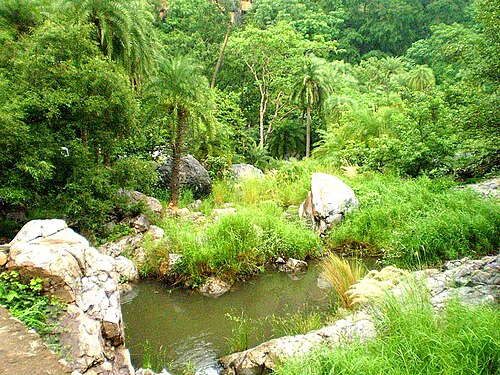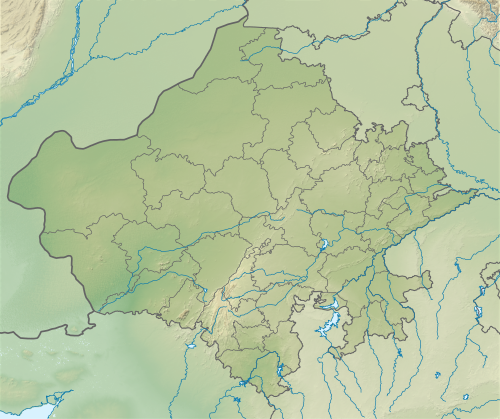
Table of Contents
Introduction to Sariska Tiger Reserve
Sariska Tiger Reserve is situated in the Aravalli hills of Rajasthan and is one of India’s most intriguing protected sites, having a unique blend of wildlife, history, and heritage.

Spanning an approximate area of 866 square kilometers, Sariska not only provides a refuge for tigers but also a secure shelter for leopards, striped hyenas, jackals, wild boars, and numerous birds.
Being different from all other regional parks, Sariska is remarkable in that it harmoniously fuses nature with heritage.
There are ancient ruins, forts, and temples existing together with thick forests, and this creates an atmosphere where wildlife blends with history.
Besides being spellbound by the excitement of catching sight of a tiger in its natural habitat, the tourists are also enchanted by the eternally attractive landmarks such as the Kankwari Fort and Pandupol Hanuman Temple.
Declared a wildlife sanctuary in 1958 and subsequently a Tiger Reserve in 1978 under Project Tiger, Sariska has served a crucial purpose as far as the conservation of India’s tiger is concerned.
This is not a tale of safeguarding animals alone, but also of rejuvenating an ecosystem that was on the verge of extinction.
Today, Sariska Tiger Reserve welcomes nature enthusiasts, wildlife photographers, and history buffs alike, making it Rajasthan’s most diverse and appealing regional park.
Historical Background of Sariska Wildlife Sanctuary
The past of Sariska Wildlife Sanctuary is as fascinating as its scenery. A former royal hunting reserve of the Alwar state, the area was renowned for tiger, leopard, and other game reserves.
The Alwar kings would frequently hold large-scale shikar (hunting) expeditions, and Sariska symbolized princely extravagance and might.
But with the lapse of time and rising hunting pressure, the number of tigers started dwindling seriously.
In order to appreciate the ecological significance of the region, the Indian government proclaimed it a wildlife sanctuary in 1958.
Twenty years later, in 1978, it was included in the elite Project Tiger program, becoming a tiger reserve in the process.
However, Sariska’s saga was not smooth sailing. By 2005, the reserve was in the news for a sad reason—the tiger population of the reserve had vanished entirely because of poaching.
The shocking incidence served as a wake-up call for Indian conservation officials. A move was initiated shortly to relocate tigers from Ranthambore National Park as part of a world’s first successful tiger relocation in the wild.
Now, Sariska is an epitome of strength. It shows how strong conservation efforts can restore life to a dying environment.
From a dying ecosystem to a successful tiger reserve, the story of Sariska Wildlife Sanctuary is an incredible story in the history of Indian conservation.
Geography and Landscape of Sariska
Sariska Tiger Reserve lies in the Alwar district of Rajasthan and is enclosed by the grand Aravalli mountain range, which is one of the world’s oldest mountain ranges.

The terrain of the park varies from scrub-thorn arid forests to dry deciduous forests, rocky hills, grasslands, and deep valleys.
This diverse topography makes Sariska stand apart from most other regional tiger parks in India.
While most tiger reserves are characterized by thick tropical forests, Sariska’s topography displays Rajasthan’s dry nature, imparting to it a unique ecological identity.
Forest and Vegetation
The forest cover is dominated by dhok trees (Anogeissus pendula) that constitute about 90% of the forest cover.
Other trees found in the area include salar, kadaya, ber, and khair. These dry forests offer an important shelter for the carnivores and grazing land for the herbivores.
Water Bodies:
Although it is situated in a semi-arid region, Sariska boasts various perennial streams, natural lakes, and artificial reservoirs.
Key among them are Siliserh Lake and Mansarovar Lake, which act as crucial water sources for wildlife and migratory birds.
Altitude and Climate:
The altitude of the reserve ranges from 300–722 meters above sea level. Summers are extremely hot, sometimes reaching temperatures above 45°C, while winters are fairly mild and pleasant, making it the best season to undertake safaris.
This exclusive combination of rock landscapes, valleys, and open forests makes Sariska host an extensive diversity of biodiversity.
In contrast to other regional parks, where dense greenary prevails, Sariska’s rough landscapes stand forth as a symbol of Rajasthan’s desert-forested landscape.
Rich Biodiversity of Sariska Tiger Reserve
What makes Sariska Tiger Reserve stand out is its unbelievable diversity. From top predators to small migratory birds, the sanctuary provides refuge to a diverse range of species, and thus is one of the most crucial sanctuaries of wildlife in North India.
Mammals
Tigers: The pride of Sariska, Bengal tigers were reintroduced here in 2008 after the 2005 extinction crisis. The numbers have since then been increasing at a steady rate.
Leopards: Leopards, renowned for their stealth, are commonly spotted in the rocky landscapes and less-disturbed regions of the park.
Hyenas and Jackals: Secondary carnivore population includes striped hyenas, jackals, and jungle cats.
Herbivores: Large herbivore populations of sambar deer, nilgai (blue bull), chital (spotted deer), wild boar, and langurs support the food chain.
Birdlife
Sariska Wildlife Sanctuary is also a paradise for birdwatchers as more than 200 bird species are found there.
Winters have migratory birds like sand grouse, crested serpent eagles, and great Indian horned owls. Wetlands and lakes invite waterbirds such as egrets, herons, and kingfishers.
Reptiles and Amphibians
Monitor lizards, snakes, and marsh crocodiles are found in the reserve. The reptiles serve a crucial purpose in keeping ecological balance intact.
Flora
Other than dhok trees, Sariska is enriched with undergrowth and medicinal herbs. Grasses and bushes form the fodder for grazing animals, while old banyan and peepal trees contribute to the personality of the sanctuary.
This high biodiversity makes Sariska Tiger Reserve not only another reserved forest but an ecologically important zone in India’s regional parks.
It facilitates the survival of dry forest-dependent species that are routinely neglected in conservation plans in favor of tropical forests.
The Role of Project Tiger in Sariska
The history of Sariska Tiger Reserve will not be complete without Project Tiger, India’s most ambitious wildlife conservation programme.
Sariska was included under Project Tiger formally in 1978, which established it as an important habitat for tigers.
The reserve once had a thriving population of Bengal tigers. However, with rampant poaching, ineffective protection systems, and human encroachment, the tigers started declining drastically.
In 2005, the shocking reality came to light—Sariska lost all its tigers. This tragic news hit the world headlines, fueled anger, and raised questions about India’s conservation policies.
But Sariska’s tale did not end there. Conservationists and the government, determined to reactivate the sanctuary, took an unprecedented step—the world’s first tiger re-location program.
Tigers from the Ranthambore National Park were trapped and re-released into Sariska between 2008 and 2010.
This reintroduction effort succeeded, and Sariska rang once more with the tiger’s roar. Today, numbers have grown steadily, with natural breeding stabilizing populations.
This incredible resurrection has transformed Sariska into a model for wildlife revival and a beacon of hope for how science, citizen action, and resolve can rescue threatened species.
Therefore, the work of Project Tiger in Sariska is not merely conservation—it is a tale of hope, grit, and second chances to one of Rajasthan’s most legendary regional parks.
7 Breathtaking Facts About Sariska Wildlife Sanctuary
Sariska Tiger Reserve is abounding in distinctive characteristics that differentiate it from other wildlife sanctuaries in India.
Find below 7 astonishing facts that bring out its distinctive identity:
The First Relocation of Tigers in the World
In 2005, Sariska’s tigers were poached. But rather than giving up, India made history by relocating tigers from Ranthambore to Sariska.
It was the first successful relocation of the world’s tigers to a natural habitat. Now, Sariska boasts a thriving population of Bengal tigers, a testament to the power of nature once properly protected.
Kankwari Fort – A Fort Within a Tiger Reserve
Unlike most of the other regional parks, Sariska boasts a historical monument in its jungles—the Kankwari Fort. Constructed during the 17th century, the fort was once a fortress of the Alwar rulers.
It is historically recollected as the jail where Mughal emperor Aurangzeb imprisoned his brother Dara Shikoh.
The fort now remains a silent eyewitness to history while presenting an enchanting view of the jungle, where tigers and leopards now amble around.
A Paradise for Birdwatchers
Sariska Wildlife Sanctuary is not just about tigers—it is also a bird lover’s paradise. With over 200 recorded bird species, it attracts both resident and migratory birds.
Crested serpent eagles, white-throated kingfishers, golden-backed woodpeckers, and peafowls are commonly spotted.
In winter, migratory species such as sand grouse, storks, and harriers make Sariska their seasonal home, turning it into a birdwatcher’s dream.
Unique Habitat Diversity
One of the most interesting things about Sariska Tiger Reserve is that it has a diversity of habitats.
Unlike dense green forests located in other tiger reserves, Sariska’s dry deciduous forests, scrub, grasslands, and rocky hills are an indication of Rajasthan’s regional park ecology.
Its diversity is home to a diverse array of wildlife ranging from top predators such as leopards and tigers to herbivores such as sambar deer and nilgai.
Ancient Temples Within the Sanctuary
Sariska is not only about wildlife; it is also spiritually significant. Pandupol Hanuman Temple, which is said to be related to the Pandavas of the Mahabharata, lies inside the sanctuary.
Thousands of pilgrims go to this temple on Tuesdays, mixing religion with nature. Other Shiva and Ganesha temples of yesteryears are dotted throughout the reserve, making Sariska an unusual combination of spirituality and wildness.
Vast Area Spanning 866 Sq. Km
Spreading over an area of 866 square kilometers, Sariska is among the largest regional parks in the state of Rajasthan.
It has core and buffer areas that are large enough to support tigers and other wildlife species.
The vast area also supports various safari zones so that tourists get a chance to see varied landscapes and ecosystems in the same reserve.
A Mix of Culture, Heritage, and Wildlife
What really sets Sariska Wildlife Sanctuary apart is its complete combination of culture, history, and wildlife.
Where else can you catch a glimpse of a Bengal tiger in the vicinity of a thousand-year-old temple, or see deer grazing under the shadow of a medieval fort?
Sariska has this combination of heritage and nature that puts it in a league of its own among all tiger reserves in India.
Safari Experience in Sariska Tiger Reserve
A trip to Sariska Tiger Reserve is not complete without enjoying its exciting safaris. The reserve provides both jeep safaris (6-seater) and canter safaris (20-seater), which enable tourists to venture into the core zones of the forest.
Jeep Safari: For small groups and photographers, as it is convenient and offers greater access to twisting forest roads.
Canter Safari: For large groups and families, to enjoy a group experience into the wilderness.
Safari Zones
Sariska is segregated into various safari zones, each with its own landscape and wildlife pattern.
Some areas are well known for tiger sightings, while there are others that are suitable for bird watching and herbivore sightings. This makes every safari an exclusive one.
Wildlife Encounters
Besides the royal Bengal tiger, one can usually find leopards, hyenas, jackals, sambar deer, chital, and wild boars.
The excitement of following the new pugmarks and hearing alarm calls of deer or monkeys makes each safari thrilling.
Safari Timings
Morning Safari: Takes off at sunrise and lasts for approximately 3 hours
Evening Safari: Takes place in the late afternoon and goes on until sunset
The times vary seasonally with daylight. Winters are particularly favored for safaris since the climate is fine and wildlife action is greater closer to water points.
Eco-Tourism and Rules
Safaris are operated under strict regulations by the Forest Department to ensure minimal impact from humans.
Noise management, predetermined routes, and limited daily entries guarantee that wildlife is not harassed.
Eco-tourism activities also involve local communities, making Sariska not only a wildlife reserve, but a model of sustainable tourism as well.
Best Time to Visit Sariska Tiger Reserve
When planning a trip to Sariska Tiger Reserve, timing plays a crucial role in ensuring a memorable experience.
Since the reserve lies in Rajasthan’s semi-arid zone, seasonal changes directly affect wildlife sightings and visitor comfort.
Winter (October to March) – The Best Season
Winter is certainly the best season to see Sariska Wildlife Sanctuary. Weather is pleasant with temperatures varying between 8°C and 25°C, making safaris comfortable.
The comfortable weather also brings about higher wildlife activity during the day. Tigers, leopards, and other wildlife tend to venture near waterholes and open areas, increasing the chances of the guests catching glimpses of them.
Other migratory birds like storks, sandpipers, and harriers also descend on this season, making Sariska a birdwatcher’s paradise.
Festivals like Makar Sankranti and Gangaur, which are observed in surrounding villages during this time, also enable tourists to imbibe local culture as well as wildlife.
Summer (April to June) – For the Adventurous
Summer in Sariska may be brutal, with temperatures crossing 40°C during May and June. But then again, the season has its perks for wildlife lovers.
Because the forest dries up, animals are then concentrated around the few waterholes left, thereby facilitating sightings.
Photographers like summer safaris due to the dry terrain, which maximizes visibility, and dramatic light conditions offer beautiful wildlife photographs.
Tourists, however, need to gear up for sizzling heat with adequate water, sunscreen, and light cotton clothes.
Monsoon (July to September) – The Green Season
During the monsoon, Sariska Tiger Reserve turns green. The dry forests become verdant landscapes, streams get filled, and the air becomes cool.
While safaris are closed during heavy rains to maintain safety and minimize disturbance of animals, the area is accessible for cultural tours.
The monsoon season is ideal for anyone interested in witnessing the rural parks of Rajasthan in their fullest green color.
But because tiger sightings are difficult due to heavy foliage, this is not the ideal time for committed wildlife photography.
Summary: October to March is the best time to view wildlife, summer is ideal for photographers, and monsoon for lovers of nature.
Conservation Challenges and Community Involvement
Though Sariska Tiger Reserve has achieved impressive strides in restoring its tiger population, it still encounters a lot of conservation challenges.
Conservation of wildlife within an area where human settlements also coexist demands a fine balance.
Poaching and Illegal Activities
The 2005 tiger extinction demonstrated how risky poaching was. Although tighter patrolling is in effect now, poaching threats and illegal grazing continue unabated.
The government employs advanced technology such as camera traps, drones, and satellite tracking to monitor wildlife movement and deter illegal hunting.
Human-Wildlife Conflict
Villages that are in the vicinity of Sariska Wildlife Sanctuary tend to have conflict with wild animals.
Leopards, hyenas, and even tiger tend to attack livestock, causing financial losses for villagers.
The government compensates these losses by providing compensation schemes and promoting community-based conservation programs.
Relocation of some villages from the core zone to the buffer area has also minimized direct conflict and provided wildlife with increased space for survival.
Pressure from Tourism
Whereas tourism brings in money and awareness, it can also disrupt the sensitive environment if not controlled.
Overcrowding of safari vehicles, noise pollution, and littering are threats to animals. In an attempt to combat this, the Forest Department tightly controls the amount of safaris offered daily, sensitize tourists on how to travel responsibly, and encourage eco-tourism.
Community Involvement – The Key to Success
More crucial, perhaps, to Sariska’s rebirth has been its community involvement. Villagers who used to rely on the forest have been trained as safari guides, drivers, and eco-tourism operators.
This creates a vested interest for them in conserving wildlife rather than utilizing it.
Women self-help groups also help by advocating handicrafts and cultural tourism, which lightens the pressure on the sanctuary.
The active participation of people ensures that Sariska Tiger Reserve is not only shielded by law but by the community’s will too.
Conclusion – The Timeless Charm of Sariska Tiger Reserve
The Sariska Tiger Reserve journey is indeed inspiring—one that testifies to India’s strong passion for conserving its natural wealth.
From being announced as a national park in 1982, losing its tiger inhabitants by 2005, and afterwards being the location of the world’s first tiger translocation project, Sariska has witnessed despair and victory.
Today, it is one of Rajasthan’s most precious regional parks, where the tiger’s roar rings out again, along with the invocations from ancient temples and migrant birdsongs.
Sariska is not about tiger-sighting—it is about seeing the strength of nature, the coexistence of culture and wild, and the value of conservation in the contemporary world.
For nature lovers, historians, spiritualists, and environmentalists, Sariska Wildlife Sanctuary provides a unique experience in which history, religion, and nature come together in a single geography.
Sariska, in the midst of Rajasthan, thrives to this day—not just as the abode of the regal Bengal tiger but also as testament to the fact that when humanity is united with nature, miracles are possible.
